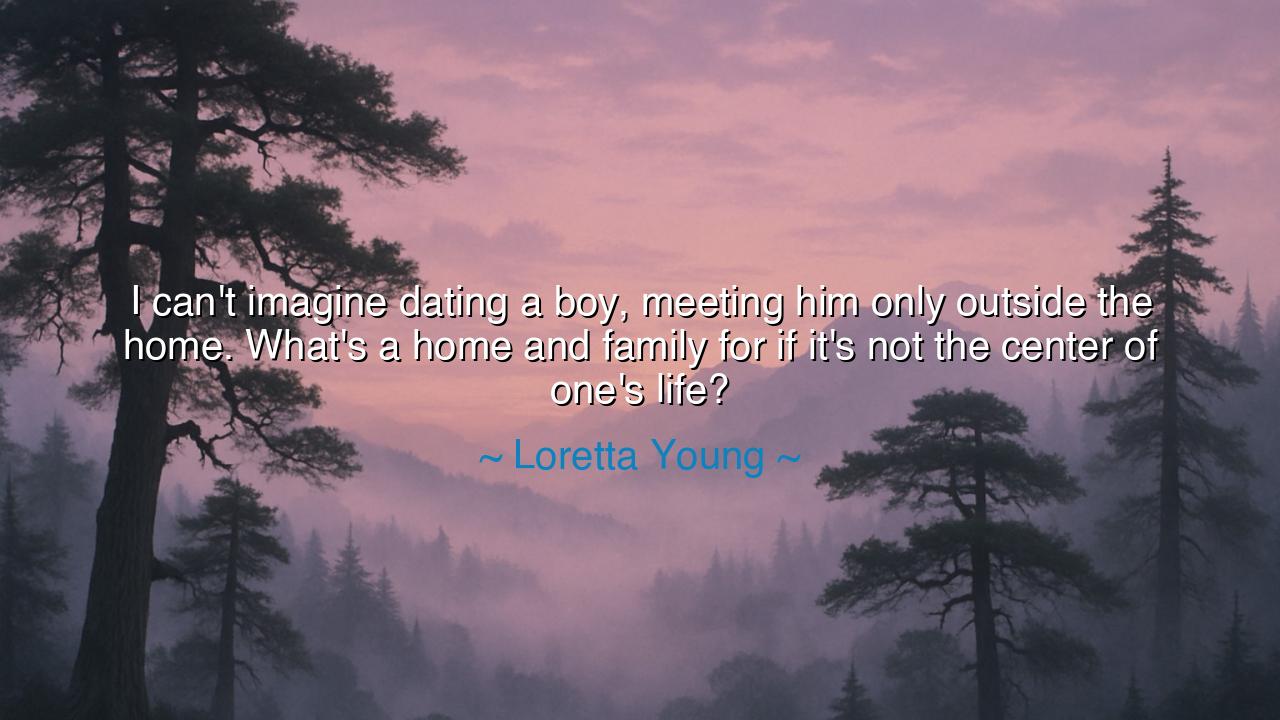
I can't imagine dating a boy, meeting him only outside the home.
I can't imagine dating a boy, meeting him only outside the home. What's a home and family for if it's not the center of one's life?






There are words that remind us of the sacred spaces we too often overlook — words that lift the veil from the ordinary and reveal the divine heartbeat within. Such are the words of Loretta Young, who once said: “I can't imagine dating a boy, meeting him only outside the home. What's a home and family for if it's not the center of one's life?” In this gentle reflection lies a wisdom as old as humanity itself: that the home is not merely a dwelling of walls and rooms, but the living temple of the heart — the cradle of virtue, the training ground of love, and the sanctuary of the soul.
To “meet him only outside the home,” as Young says, is to live love as a fleeting adventure rather than a sacred participation in the rhythm of life itself. In the world she evokes, love does not exist apart from the family, but within it — seen, shared, and shaped by those who hold us most dear. Her words harken back to a time when love was not a private escapade, but a woven bond between two families, two homes, two lineages. In her view, to love well is not to escape into secrecy, but to root affection in the soil of belonging — to let it grow in the presence of those who have raised, guided, and molded our character.
This reverence for the home as the center of life is not unique to Loretta Young; it echoes the wisdom of countless generations before her. The ancients spoke of the oikos, the household, as the foundation of all society. The Greek philosopher Aristotle wrote that the stability of the city-state began in the harmony of the home — that those who learned justice and kindness within their own hearth would carry those virtues into the world. Likewise, in many ancient cultures, a suitor was welcomed not in secret gardens or dimly lit parlors, but in the open presence of the family, for it was believed that love should grow under the light of honor, transparency, and shared joy.
Consider the story of Ruth and Boaz from the ancient Scriptures. Their love did not begin in whispered secrecy or chance encounter, but within the context of family and faith. Ruth’s loyalty to her mother-in-law Naomi, her humility in work, and her devotion to her household became the very virtues that drew Boaz’s heart. Their union was blessed not because it was passionate alone, but because it was rooted in righteousness — witnessed by family, embraced by community, and blessed by God. It is this kind of love, grounded in the home’s sacred order, that Loretta Young calls us to remember — a love that does not isolate, but integrates.
When Young asks, “What’s a home and family for if it’s not the center of one’s life?” she is not merely defending tradition; she is expressing a philosophy of wholeness. In an age where many seek identity and meaning in outward pursuits — in career, in wealth, in fleeting pleasures — she reminds us that the truest center is not found in the noise of the world, but in the quiet constancy of home. For it is there that character is forged, that kindness is taught, that patience is tested, and that love, once planted, finds its deepest roots. The home is the original school of the soul — where one learns not only to be loved, but to love rightly.
There is also, within her words, a warning — that love which does not touch the home, which lives only in public places and passing moments, may never mature into the enduring companionship the soul longs for. True love must be able to stand in the light of daily life — to laugh with parents, to comfort children, to endure the ordinary and the imperfect. The love that cannot survive the scrutiny of family, the warmth of home, or the simplicity of shared meals is not love but infatuation disguised as intimacy. In this, Loretta Young speaks not as a moralist, but as a sage — one who understands that the measure of love is not its passion, but its peace.
The lesson, then, is both ancient and eternal: do not seek love that hides from the home; seek love that strengthens it. When you love, do so in the light — let your affection be seen by those who know you best, and let it harmonize with the rhythm of family and community. Do not let your heart wander through the world as if love were a transaction or an escape. Instead, let your home — your place of origin, your place of return — be the sacred axis upon which your relationships turn. For in the end, it is not the noise of the crowd or the glamour of romance that endures, but the gentle, steady flame of love that warms the hearth.
So, as Loretta Young teaches, cherish the home not as a backdrop to life, but as its heart. Let every relationship you nurture be an extension of that heart — honest, rooted, and shared. And remember always: the home is not merely where you live; it is where you learn how to live. To honor it, to make it the center of your love and your choices, is to walk in harmony with the wisdom of the ages — and to find, in that harmony, a peace that the world can neither give nor take away.






AAdministratorAdministrator
Welcome, honored guests. Please leave a comment, we will respond soon